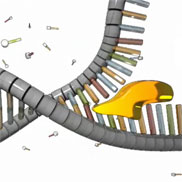
How is DNA replicated?
Replication occurs in three major steps: the opening of the double helix and separation of the DNA strands, the priming of the template strand, and the assembly of the new DNA segment. During separation, the two strands of the DNA double helix uncoil at a specific location called the origin. Several enzymes and proteins then work together to prepare, or prime, the strands for duplication. Finally, a special enzyme called DNA polymerase organizes the assembly of the new DNA strands. The following description of this three-stage process applies generally to all cells, but specific variations within the process may occur depending on organism and cell type.
















